#henri ii de bourbon condé
Explore tagged Tumblr posts
Text
"It is something that must be remedied". Dueling, noble privilege, honor, and the authority of the State.
At the Assembly of Notables, the king's friends Marshals La Force and Bassompierre complained that although the noble order had saved Henry IV's throne when the other orders had "deserted" him, now they found themselves pushed unceremoniously out of judicial and financial offices and even the king's council. Louis XIII replied cautiously that he intended to "favor his nobility with all the advantages he could." In the next few months he responded with a mixture of token concessions and severe demands. On the benign side, he tried (in vain) to make nobles engage in ignoble commerce by legalizing it, and he gave them a monopoly of household offices and top military and ecclesiastical posts. On the disciplinary side, he slashed their pensions, added yet another edict against dueling (superseding those of 1623 and 1624), set up a noble commission to authorize the demolition of chateau and town fortifications in the interior of the realm, and made it a capital offense to attack state policies and their authors (i.e., Richelieu) in printed tracts. Richelieu's hand can be seen in both the benign and the harsh sides of these reforms; Louis hand is especially evident in the latter.
The most spectacular example of Louis XIII's reforming action involving the nobility during this period was the execution of Bouteville for dueling. Francois de Montmorency, count of Bouteville, was a member of a distinguished provincial family and had the best connections at court. He embodied the noblest qualities of the fearless warrior in Louis's battles with the Huguenots. Unfortunately, he was also, at age twenty-seven, the champion dueler of France. Richelieu exaggerated only slightly in saying that Bouteville had his hand in every duel in France between 1624 and 1627. Some sort of showdown with Louis XIII was inevitable.
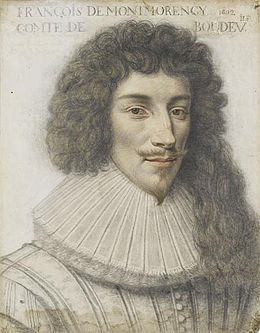
Just before Richelieu's rise to power Louis had tried to enforce an earlier revision of antidueling laws. But Bouteville had fled, and dueling tapered off. It reemerged in 1626. The count was in the thick of the fight, having returned to France just as the old law he had transgressed expired and the new —and more enforceable— edict of February 1626 was being unveiled. Combining the king's determination and his leading minister's ingenuity, the edict of 1626 addressed the pronoble parlementary judges' objection to executing every transgressor of previous laws. Duelers were put on notice that if they dueled or challenged anyone to a duel one on one, they would be stripped of their public posts; if they dueled with seconds —("Three Musketeers"-style) or killed an opponent, they would die. Furthermore, common knowledge alone��rather than virtually unobtainable witnesses, could send a nobleman to the executioner's block.
No one paid any attention. Louis himself seemed ambivalent, for he let his disgraced favorite Barradat off with only banishment from court. Bouteville's case, however, was different from all the rest: he was forever getting involved in elaborate, blood-shedding duels over his honor, even when he tried to run away from them! Just before implementation of the new edict, he engaged in a duel of three against three that ended the lives of two opponents, including yetanother boyhood companion of King Louis. At the beginning of 1627 Bouteville was drawn into yet another duel after his opponent, La Frette, called him a coward for refusing his challenge. A Bouteville second was killed, and the ace dueler promptly fled with his cousin Chapelles to the Spanish Netherlands to escape the new edict's penalties.
Louis XIII unwittingly led Bouteville at long last to his doom by giving the honor-ridden young man a partial pardon that looked like a slight: he would not be prosecuted if he returned to French soil but stayed away from court. Stung by this affront, Bouteville decided to evade no longer the baron of Beuvron, the would-be revenger of his last dueling victim, who had come unsuccessfully all the way to Brussels to challenge him. They fought a multiple duel, in the most public place in Paris Bouteville could think of to uphold his honor against his noble opponent and his royal master —the fashionable Place Royale.
Observers reported the king as being "so offended" that he sent Bassompierre after the fleeing Bouteville and Chapelles with Swiss guards, asked the parlementary prosecutors if the duo could be taken dead or alive, and "expressed great joy" at the news of their capture (while Richelieu and Marillac merely shrugged their shoulders and went on with their work). The instigator of the duel, Beuvron, escaped to England.
As the trial proceeded, Louis managed to keep his emotions in check. When Bouteville's wife, three months pregnant, fell on her knees after mass, the king avoided her, commenting: "The woman brings me pity, but I wish to and must maintain my authority." The condemned man's uncle by marriage, Condé, got nowhere with the typical male noble arguments: "He has failed by error of the custom of your kingdom, which makes honor consist of undertaking perilous actions…. The universal quest for glory, not a personal design to disobey you, drew him into this disobedience."
It is possible that Louis might have been swayed had Richelieu not constantly argued that a test case be made of Bouteville's flagrant defiance of the law. But, as we have seen in our discussion of the royal-ministerial partnership, the minister also made counterarguments for clemency. Richelieu later wrote that he had never been more shaken than by this conflict of values, and by appeals that came from his own family.
After the Parlement had sentenced Chapelles and Bouteville to decapitation, and their opponents to hanging in effigy, Louis armed himself as best he could against the shrieks of Condé's wife and the fainting of Mme de Bouteville. He cited his edicts, conscience, oath, and the blood of his nobility, "for which he had to answer to God." To Charlotte de Montmorency-Condé's cries for mercy he answered: "Their loss moves me as much as you, but my conscience forbids me to pardon them." According to the royal historiographer Bernard, Louis also exclaimed: "It is necessary for a little blood to be shed in this instance to stop the stream that flows daily." Louis XIII insisted that the execution be public, nervously ordered the guards to seize anyone who so much as called for "grace," and had the surrounding streets blocked off with chains and carts.
Bouteville and Chapelles died bravely and repentant for their crimes, dignifying a scene that must have sickened the entire court. Louis himself had to be bled a week later, and immediately fell dangerously ill. Was it worth it? Bernard contended that dueling was lessened, and history has accepted his verdict. In truth, the death on 22 June 1627 of a young nobleman who had killed twenty-two opponents was an exceptional act of state. In contrast to Henry IV and Marie de' Medici, who had condoned the socially acceptable crime of private dueling, Louis XIII simply said that state order was incompatible with flagrant lawless behavior in the name of noble honor.
During the rest of his reign Louis chose carefully where to draw the line. The axe fell on a beloved captain of the king's guards, but spared Protestant and Catholic officers in 1627-28, including Richelieu's cousin, who tried to settle the last of the religious wars by ritual duels. In 1636 Richelieu wrote to Louis that dueling had reappeared, to which the king replied: "It is something that must be remedied."
A. Lloyd Moote - Louis XIII the Just
#xvii#a.lloyd moote#louis xiii the just#louis xiii#cardinal de richelieu#françois de montmorency-bouteville#house of montmorency#michel de marillac#françois de rosmadec comte de chapelles#guy d'harcourt comte de beuvron#élisabeth-angélique de vienne#charlotte-marguerite de montmorency#henri ii de bourbon-condé#dueling#executions#richelieu: sire il est question de couper la gorge aux duels ou de couper la gorge aux lois de votre majesté#also richelieu: i also have strong arguments ready in case you lean for clemency#bouteville: watch me go out in style
13 notes
·
View notes
Text
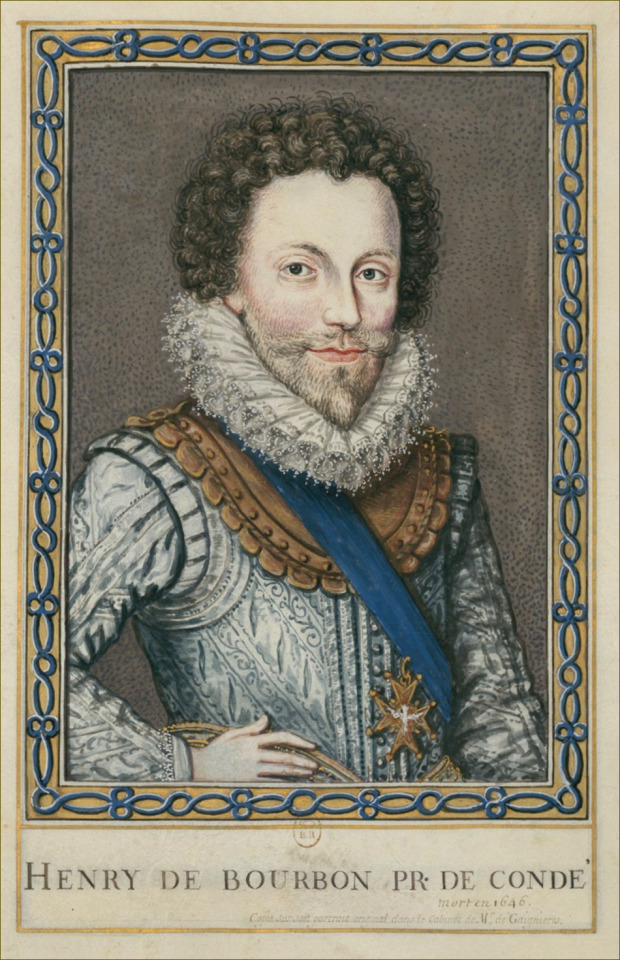
Henri II de Bourbon, Prince de Condé.
#royaume de france#french aristocracy#henri ii de bourbon#prince de condé#maison de bourbon#bourbon condé
6 notes
·
View notes
Text
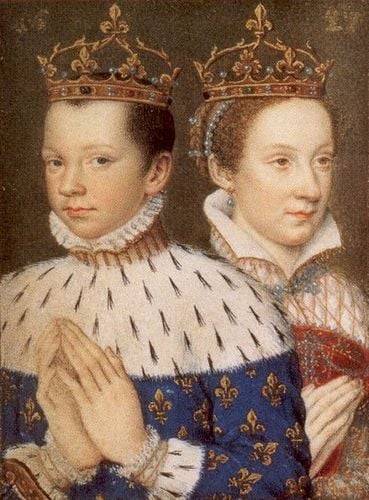
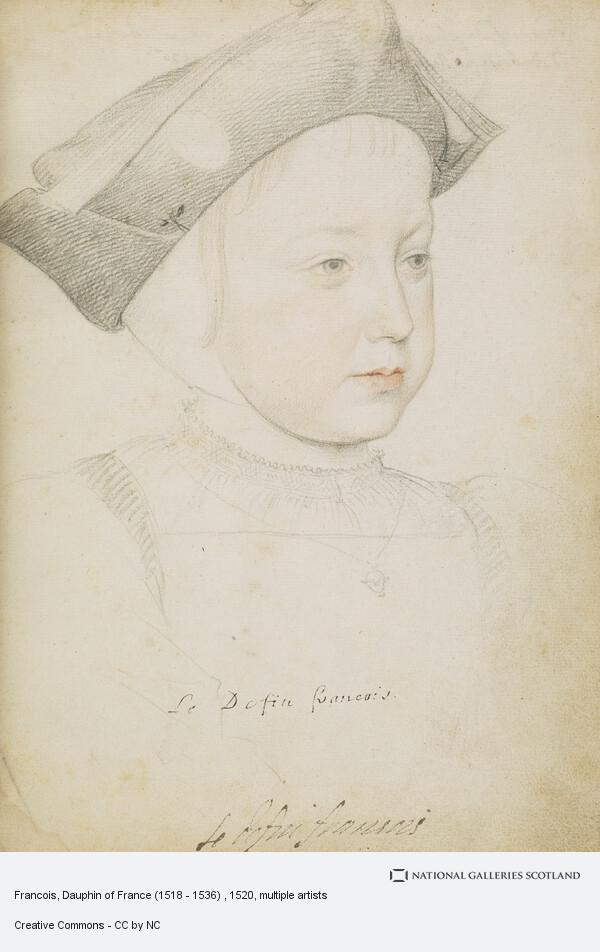
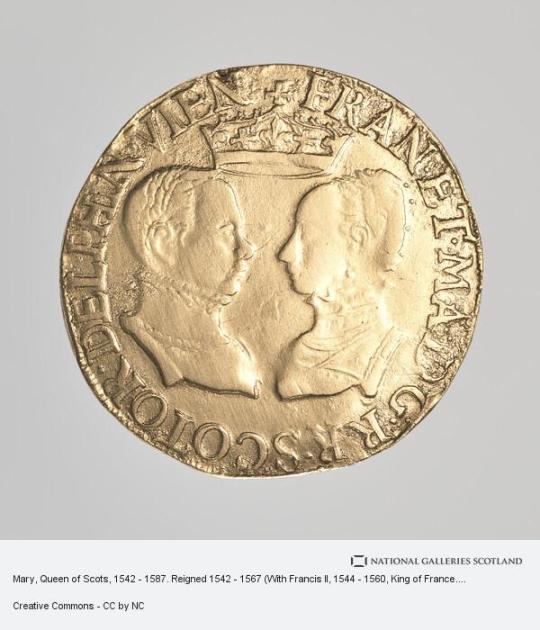
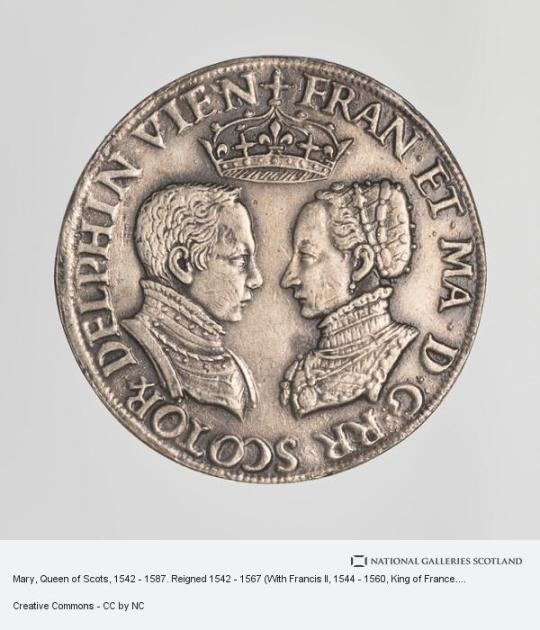
On December 5th 1560 King Francis II of France, the husband of Mary Queen of Scots, died.
Although not crowned it has to be remembered that Francis was also King consort of Scotland.
Francis was born on 19 January 1544, the eldest son of Henry II of France and Catherine de Medici, he was named for his grandfather, King Francis I.
When Francis was four years old, the Scots and French signed the Treaty of Haddington in July 1548 arranging the betrothal of Mary Queen of Scots and the dauphin Francis in return for French aid to expel the invading English. Mary Queen of Scots sailed from Dumbarton for France in the August of 1548 when she was but five years old. The young Queen was accompanied by her four Marys, the daughters of Scottish noble families, Mary Beaton, Mary Seton, Mary Fleming and Mary Livingston.
Mary spent the rest of her childhood at the court of her father-in-law, Henri II Her father-in-law, Henry II of France wrote 'from the very first day they met, my son and she got on as well together as if they had known each other for a long time'. Mary was a pretty child and brought up in the same nursery as her future husband and his siblings, became very attached to him. She corresponded regularly Mary of Guise , who remained in Scotland to rule as regent for her daughter. Much of her early life was spent at Château de Chambord. She was educated at the French court learning French, Latin, Greek, Spanish and Italian and enjoyed falconry, needlework, poetry, prose, horse riding and playing musical instruments.
Mary was the cosseted darling of the French court, the doting Henri II wrote 'The little Queen of Scots is the most perfect child I have ever seen.' He corresponded frequently with Mary of Guise, expressing his delight in his young daughter-in-law. Mary's maternal grandmother, Antoinette of Guise, in a letter to her daughter in Scotland, stated that she found Mary ' very pretty, graceful and self assured.'
Francis and Mary were married with spectacular pageantry and magnificence in the cathedral of Notre Dame, Paris, by the Cardinal Archbishop of Rouen, in the presence of Henry II, Queen Catherine de' Medici and a glittering throng of cardinals and nobles. The French courtier Pierre de Brantôme described Mary as ‘a hundred times more beautiful than a goddess of heaven … her person alone was worth a kingdom.’
Among the wedding guests was one, James Hepburn Earl of Bothwell. Francis was fourteen and Mary fifteen at the time, Francis then held the title King consort of Scotland until his death.
When Henri II was killed during a jousting contest, incidentally by Gabriel de Lorges, Comte de Montgomery, Captain of The Scots Guard, and a descendant of Alexander Montgomerie of Auchterhouse, Mary's young husband Francois ascended the throne. Francis was reported to have found the crown of France so heavy that the nobles were obliged to hold it in place for him.
The young Francis became a tool of Mary's maternal relations, the ambitious Guise family, who seized the chance for power and hoped to crush the Huguenots in France. The Huguenot leader, Louis de Bourbon, prince de Condé plotted the conspiracy of Amboise in March 1560, an abortive coup d'etat in which Huguenots surrounded the Château of Amboise and attempted to seize the King. The conspiracy was savagely put down, and its failure led to increase the power of the Guises. This alarmed the king 's mother, Catherine de Medici, who reacted by attempting to secure the appointment of the moderate Michel de L'Hospital as chancellor.
During the autumn of 1560 François became increasingly ill, and died from the complications of an ear condition, in Orléans, Loiret. Since the marriage had borne no children, the French throne passed to his 10-year-old brother, Charles IX. Mary was said to be grief-stricken Multiple diseases have been suggested as the cause of Francis' death, such as mastoiditis, meningitis, or otitis exacerbated into an abscess. Francis was buried in the Basilica of St Denis.
There was no place for the seventeen year old Mary, Queen of Scots in France, she prepared to return to her native Scotland with an uncertain future that would hold.
17 notes
·
View notes
Text

Portrait of Louis I de Bourbon, Prince de Condé (1530-1569)
Artist: Workshop of François Clouet (French, 1510–1572)
Date: 16th Century
Medium: Oil on Panel
Collection: Private Collection
Portrait of Louis I de Bourbon, Prince de Condé (1530-1569), bust-length, in a gold-embroidered doublet
Louis de Bourbon, 1st Prince of Condé (7 May 1530 – 13 March 1569) was a prominent Huguenot leader and general, the founder of the Condé branch of the House of Bourbon. Coming from a position of relative political unimportance during the reign of Henri II, Condé's support for the Huguenots, along with his leading role in the conspiracy of Amboise and its aftermath, pushed him to the centre of French politics. Arrested during the reign of Francis II then released upon the latter's premature death, he would lead the Huguenot forces in the first three civil wars of the French Wars of Religion before being executed after his defeat at the Battle of Jarnac in 1569.
#portrait#french renaissance#prince#francois clouet#oil on panel#european nobility#16th century#french art
1 note
·
View note
Text
Jour 02.
Henri II de Bourbon-Condé, Prince de Condé.
Henri IV maria le jeune Henri II de Bourbon-Condé, prince de Condé, à Charlotte de Montmorency.
Il espérait ainsi pouvoir se faire la donzelle puisque le jeune Condé était réputé préférer les hommes.
instagram
0 notes
Photo
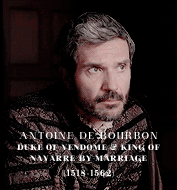
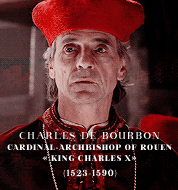
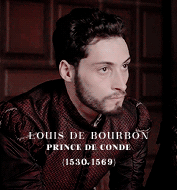
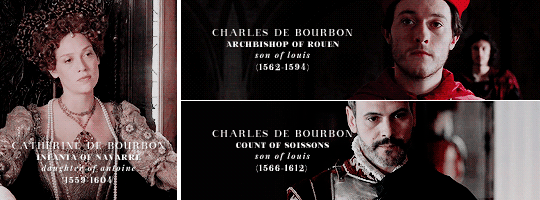



prominent members of the Bourbon-Condé Family (16th-17th century)
#historyedit#documentaryedit#perioddramaedit#versaillesedit#mine#*#16th century#17th century#louis xiv#louis xiii#henri iv#the bourbon family#the condé family#catherine de bourbon#anne-geneviève de condé#armand de conti#louis ii de condé#henri i de condé#henri ii de condé#charles ii de bourbon#charles de bourbon#louis i de condé#antoine de bourbon#françois de conti#it's a bit of a mess rip
254 notes
·
View notes
Text
This Day, 20th August 1648, The Battle of Lens, The Thirty Years War.
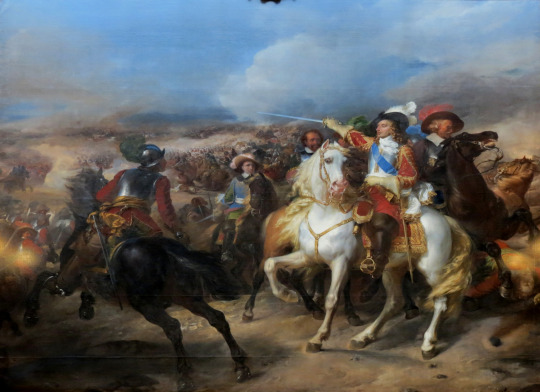
Aug 20 1648Battle of Lens
The Battle of Lens (20 August 1648) was a French victory under Louis II de Bourbon, Prince de Condé against the Spanish army under Archduke Leopold in the Thirty Years' War (1618-1648). It was the last major battle of the war.
Lens is a fortified city in the historic region of Flanders, today a major city in the Pas-de-Calais department of northern France. The city had been captured by the French in 1647. As France began to experience a rebellion of the nobility against the leadership of Cardinal Mazarin, known as the Fronde, the Spanish saw an opportunity to retake Lens and possibly gain ground. The Prince de Condé rushed from Catalonia to Flanders and an army was cobbled together from Champagne, Lorraine as well as Paris. The French army was 16,000 men (more than half were cavalry) and 18 guns. The Spanish army was larger, comprising 18,000 men (also more than half cavalry) and 38 guns. The armies drew up, but the Spanish were on high ground and Condé decided not to attack. As the French retired, the Spanish cavalry skirmished with the French rearguard and the engagement escalated until the armies were fully engaged. The Spanish infantry pushed back the French, breaking the Gardes Françaises regiment, but the superior French cavalry were able to defeat their counterparts and envelop the center.
The danger to Dutch trade from the possession of Dunkirk by the French, the proposal of France to exchange Catalonia for the Spanish Netherlands, the declining health of Frederick Henry and his death in March 1647, all contributed to stimulate the Dutchdesire for peace. Their cooperation in 1645-6 had been but slight; they now seriously prepared to treat. Though their Treaty of Münster was not concluded until January 1648, it had been settled in principle more than a year before; and the year 1647 saw the French left alone in their northern struggle with Spain. In this year Louis de Bourbon, now Prince of Conde, was occupied in Catalonia, and Turenne was detained in Germany by the revolt of the Bernardine troops. France was exhausted, and the conquests of Dixmuyden in Flanders and La Bassee between Bethune and Lille were compensated by the loss of Menin, Armentieres, and Land- recies. In October Gassion was killed at the siege of Lens. In 1648 Conde, recalled from Catalonia, was nominated to the command in Flanders. A final effort was to be made to extort peace. Ypres had been taken and Courtrai lost when in July he was summoned to Paris in consequence of the opening troubles of the Fronde. Once more at the front, and joined by Erlach with 4000 men from the army of Breisach, he advanced to the relief of Lens, which he found had already surrendered to the Archduke Leopold. Retreating towards Bethune, he enticed the Spaniards to leave their entrenchments, and a general engagement followed according to his desire (August 20). The French army, though its right wing at first was roughly handled, was completely victorious. Both wings of the Spaniards were driven in flight. Beck was wounded and captured, refused all assistance, and died of his wounds. Leopold and Fuensaldaña fled to Douai. The Spanish infantry, no longer maintaining the tradition of those who had fallen at Rocroi, surrendered in thousands. The Spanish loss was 8000 men, 30 cannon, all their baggage, and 120 banners. Six days later Paris was in revolt. Many years were to pass before a similar victory was gained by the arms of France.
Source the World History Project website
4 notes
·
View notes
Photo

LES LUMIÈRES DE VERSAILLES #leslumièresdeversailles En 1758, les Français sont défaits à la bataille de Krefeld. Le comte de Clermont qui commande l’armée française s’enfuit jusqu'à Neuss. En entrant dans la ville, il demande à l'officier de garde : - Est-il arrivé beaucoup de fuyards ? - Non, monseigneur, vous êtes le premier. 1- UNE IDÉE DE PEINTURE Le peintre François-Hubert Drouais (1727-1775) a représenté Louis de Bourbon, comte de Clermont. Ce peintre devient successivement l'élève de son père, Hubert Drouais, de Donat Nonnotte, de Carle Van Loo, de Charles-Joseph Natoire, et de François Boucher. Reçu membre de l’Académie royale, le 25 novembre 1758, sur présentation d'un portrait de Coustou et d'un portrait de Bouchardon (aujourd'hui au Louvre) comme morceau de réception, il est rapidement appelé à Versailles. 2- UN PEU D'HISTOIRE Bien qu'entré dans les ordres, le comte de Clermont (1709-1771) obtient du pape Clément XII, en 1733, l'autorisation de porter les armes. Lieutenant général en 1735, il participe aux campagnes des Pays-Bas. Chargé du commandement de l'armée de Bohême, il est vaincu à la bataille de Krefeld (1758). Il commande l'armée du Rhin en 1758. Après les déboires rencontrés par la France face à Frédéric II de Prusse lors de la guerre de Sept Ans, il élabore des plans de remise en ordre de l'armée. Il est aussi nommé gouverneur de la Champagne le 19 septembre 1751 en remplacement de Charles de Rohan-Soubise et porte le titre jusqu'en 1769 lorsqu'il la charge à son neveu Louis VI Henri de Bourbon-Condé. 3- NE MUSIQUE D'UN BONHEUR CONTAGIEUX Regardez "François Couperin - L'Apothéose de Lully (1725)" https://youtu.be/BwO-nO9dvk4 L'apothéose de Lully (titre complet : Concert instrumental sous le titre d'Apothéose composé à la mémoire Immortelle de l'incomparable Monsieur de Lully) est une sonate en trio de François Couperin parue en 1725. La sonade, selon le terme que Couperin tentera en vain d'imposer est destinée à deux dessus de viole, basse d'archet et basse continue ou deux clavecins. François Couperin, né le 10 novembre 1668 à Paris et mort le 11 septembre 1733 à Paris, est un important compositeur, organiste et claveciniste fra https://www.instagram.com/p/CiHqxmZMoK5/?igshid=NGJjMDIxMWI=
0 notes
Text
Opera Simplified #7: Les Huguenots—Notes, Act I
** Two things:
the overture (or really more of a prelude) here is not the overture Meyerbeer originally wrote, which was apparently more in a traditional overture style and was cut and replaced with this one; however, no recording has been made of the original overture, so I cannot include it here.
more important to know about this overture: yes, the tune here IS “Ein feste Bürg ist unser Gott” (“A Mighty Fortress Is Our God”), a hymn by the one, the only Martin Luther. keep the tune in the back of your head because Meyerbeer uses it as a motif throughout the opera. Yes, it is a Lutheran hymn. Yes, the vast majority of Huguenots were Calvinists. Just roll with it.
*** Admiral Gaspard II de Coligny (1519-1572) was a prominent French nobleman who converted to Protestantism in the late 1550s.
In 1562, the first of the French Wars of Religion broke out and Coligny served as a lieutenant under the Huguenot military general Louis, Prince of Condé. After Condé was executed by Catholics following his defeat, surrender, and capture at the Battle of Jarnac in 1569, Coligny became the de facto leader of the Huguenots. Well liked by King Charles IX of France, he was a voice in the French government on behalf of the Huguenots and of peace. However, this, along with (obviously) his Protestantism, made him many enemies at court.
**** As previously mentioned, Henri de Bourbon was the young Protestant King of Navarre at the time this opera takes place and was about to marry to Marguérite de Valois. Thus, it is a favor to the incoming court to have good relations with Protestant nobles.
***** This hymn, which will recur in different forms throughout the opera, is the first appearance in the opera of the previously-mentioned “Ein feste Bürg”, although in French and obviously not a 100% literal translation.
****** La Rochelle is a seaport in western France (and according to early letters by Meyerbeer, Raoul and Marcel’s hometown). During the French Wars of Religion, it was one of the Huguenots’ chief strongholds, and it declared itself independent from France in 1568. The city was famously sieged several times, most notably for about nine months in the immediate aftermath of the Saint Bartholomew’s Day Massacre. However, the conflict being referenced here is presumably a Catholic naval blockade of the city that took place in 1571, which was fiercely resisted by Huguenot forces and the city’s inhabitants.
#opera#opera tag#les huguenots#notes#meyerbeer#giacomo meyerbeer#augustin eugène scribe#émile de saint-amand deschamps
1 note
·
View note
Photo

#DoubleTrouble Antoine of Navarre and Louis of Condé were perfect trouble makers: handsome, sauve, sophisticated, powerful, complicated, and willing to destroy the Valois at all costs. Historically: Antoine de Bourbon, King of Navarre - His son, Henry III of Navarre, became Henry IV of France. He was the first Bourbon King to rule France, after the assassination of King Henry III, of the House of Valois. Louis de Bourbon, Prince of Condé, founder of the House of Condé - Following his conversion to Protestantism, Louis was instrumental in the plot to kidnap the adolescent King Francis II in the "Conspiracy of Amboise," an unfortunate missed opportunity by the Reign writers. By 1558, when a young Mary Stuart became Queen of France with Francis II, Condé was already married with 4 children. He was 12 years Mary’s senior. #BourbonBrothers #BourbonTrouble #AntoinedeBourbon #KingofNavarre #LouisdeBourbon #PrinceofConde #Reign #HistoricalFiction #HistoricalFantasy #HistoricalDrama https://www.instagram.com/p/CZwpIA_L985/?utm_medium=tumblr
#doubletrouble#bourbonbrothers#bourbontrouble#antoinedebourbon#kingofnavarre#louisdebourbon#princeofconde#reign#historicalfiction#historicalfantasy#historicaldrama
1 note
·
View note
Text
Barbin, Mangot, Luçon
Condé's incarceration intensified the power struggle between two factions equally marred by political self-seeking. The rebels' new rallying cry of avenging their leader's arrest could not overcome their moral bankruptcy as a party aimed at transferring to themselves the power and patronage enjoyed by the queen mother's Italian favorites. On the royal side, the arrest was part of a new state policy of firmly resisting rebel demands. That policy shift stemmed from the appointment during the last months of 1616 of a vigorous ministerial triumvirate: Claude Barbin, Claude Mangot, and Armand-Jean du Plessis, bishop of Luçon. The triumvirs' effectiveness was hampered, however, by popular antipathy toward the couple who had put them in power, Concini and his wife, Galigaï.
Of the three "creatures" of the Ancres, Barbin had the most influence, and eventually suffered most severely from the king's wrath after the royal coup d'état of 1617. A shrewd manipulator of money and people, this private financier had advanced his career by leasing the collection of state fees to the profit of his friend, Leonora Galigaï, then became Marie's personal financial director and finally royal superintendent of finance. Barbin took the lead among the new ministers in boldly urging Marie to oppose princely disorder.
Mangot's background was somewhat less controversial. He had parlayed a brilliant law career and legal assistance to Concino Concini into acquisition of the top post in the Parlement of Bordeaux, then briefly served as a secretary of state, and finally as keeper of the seals, thereby assuming the judicial functions —but not the office itself— of chancellor, which post was always for life.
The minister who signed his name Lusson at this time was the last of the three to enter the council, and owed a great deal of his influence with the queen mother and her Italian favorites to the patronage of Barbin. Armand-Jean du Plessis, sieur de Richelieu, was the ambitious scion on his father's side of the petty noble Richelieu-du Plessis family, which had been prone to dueling and overspending, and on his mother's side of the hardworking La Porte - Meilleraye family of robe lineage. He had already come far as bishop of Lucon, orator of the clergy at the Estates General, almoner of young Queen Anne, and personal secretary to the queen mother. In November 1616, he became secretary of state for foreign affairs.
Sympathetic biographers have read more into the future cardinal-minister Richelieu's brief conciliar career of 1616-17 than the hard evidence proves. All we can say with certainty is that he showed himself to be bright and energetic in internal and external affairs. His surviving letters to Ancre were embarrassingly fawning, even for an era that assumed the way to become a favorite at court and stay there included a large dose of flattery and obsequiousness. Luçon also revealed his driving ambition and authoritarian bent to such an extent that, at his fall in 1617, the keenly observant young Louis XIII expressed relief to be rid of his tyranny.
The triumvirate was able to hold the military edge for the royal side against Condé's followers in the desultory fighting of the last months of 1616 and the beginning of 1617, but without finding a moral cause that would definitively tip the balance in this latest miniwar. To the contrary, the ever-escalating level of the Ancre couple's conspicuous privilege and power undermined everything Barbin was attempting to accomplish, and served also to make the queen mother more vulnerable as the Ancres' patroness.
A. Lloyd Moote- Louis XIII the Just
#xvii#a.lloyd moote#louis xiii the just#henri ii de bourbon-condé#marie de médicis#concino concino#leonora galigaï#claude barbin#claude mangot#cardinal de richelieu#louis xiii#i can't believe he let some letters survive#how embarrassing#now i need to read them#ah#luçon! me voilà débarrassé de votre tyrannie!#court intrigues and coups d'état#barbin trying to put out fires everywhere#something wicked this way comes
4 notes
·
View notes
Text
Sébastien Le Prestre de Vauban: Father of the Fortress
Vauban, France’s master engineer of the 17th Century, designed nearly 100 fortress for Louis XIV—and defined the form for the ages.
Sébastien Le Prestre, who would earn renown as seigneur de Vauban and a marshal of France, was born in 1633 in a small village in Burgundy. Vauban (as he is generally known) was of minor provincial nobility with few influential family connections. He spent his early military career in the service of Louis de Bourbon, prince of Condé, during the civil war known as the Second Fronde (1650–53), as a rebel fighting against young King Louis XIV. Though royalists captured Vauban early on, the reputation the young soldier had already established stood him in good stead, for rather than being hanged as a rebel, he was interviewed by Cardinal Jules Mazarin, the king’s Italian-born adviser. Mazarin was sufficiently impressed to offer Vauban a place in Louis’ army, and the young man prudently changed sides.
Gifted with an inquiring and open mind, prodigious energy and a capacity for long hours and hard work, Vauban soon established a reputation as a gifted military engineer. He was a student of such eminent predecessors as Blaise-François, comte de Pagan (1604– 65), and blessed with a good measure of practical common sense, he developed a particular interest in both the design and construction of fortresses to modern pattern, and in the most effective ways to capture those same places at the least cost.
By the late 17th century, fortress design was based on the simple plan of the trace italienne, or star fort. The high stone walls of medieval castles had given way to low, sharply sloped, artillery-resistant embankments. This system employed geometric patterns superimposed one on another, enabling fortresses largely to withstand the devastating effects of modern gunpowder artillery and mining. The design also met the timeless demands of effective defense—establishing clear lines of fire and ensuring concealment, depth and protection. Of course, topographical variations and complexities in any location meant that a successful fortress designer had to bring his ingenuity and imagination to the basic plan, and in that regard Vauban proved a master of his craft. Any force seeking to capture one of his fortresses would pay a significant price in time, effort and blood. With his complementary keen interest in the best way to seize fortresses, Vauban also drew up a model timetable for a besieging commander, setting out in detail how his force might employ the suggested 48 days to good effect.
With the civil wars settled, Louis XIV embarked on a series of aggressive campaigns against his neighbors. In May 1667 French armies under the command of such remarkable soldiers as Marshals Henri de la Tour d’Auvergne, vicomte de Turenne, and François-Henri de Montmorency, duc de Luxembourg, marched into the Spanish Netherlands (present-day Belgium and Luxembourg) and soon placed large parts of Artois, Picardy and Flanders under French control. Having pushed his northern border outward, Louis XIV naturally wanted to strengthen the existing obsolete defenses there. His chief engineer, Louis Nicolas de Clerville, was unwell, so the king gave young Vauban the task of redesigning and strength ening the defenses of Lille, an undoubted honor for a man still junior in rank.
The remodeling and rebuilding of Lille was an enormous undertaking, the massive new citadel alone requiring some 60 million bricks. Laborers completed the work in 1674, and this set the pattern for future years, as Vauban continually hurried across France on instructions from Louis XIV and his minister for war, François-Michel le Tellier, marquis de Louvois, to survey existing defenses, devise and recommend improvements, and oversee the construction of strong new fortifications. The king could for the time being foot the vast expense, and between 1668 and 1698 Vauban designed a strong double belt of modern fortresses to shield France’s northern border, where no really strong natural obstacles existed. This system of defense was known as the pré carré (“square field”), or Fence of Iron. Among its key attributes was mutual support; Vauban’s declared intention was that no French fortress on the northern border should be out of hearing of cannon-shot from another fortress.

Renewed war, whether in search of glory or as a defensive measure against encroaching neighbors, was a regular theme of Louis XIV’s reign. The Netherlands, Spain, Austria, England (Great Britain from 1707 onward) and the German princely states all felt the power of French armies between 1672, when Louis and allies attacked the Dutch Republic, and the close of the Nine Years’ War (War of the League of Augsburg) in 1697. Armies had maneuvered, fought battles, and besieged, bombarded and stormed fortresses, but none of the warring parties had achieved anything of real value, other than Louis’ success at securing territorial gains, while firmly establishing the suspicions and enmity of his neighbors.
With the nations of Western Europe exhausted by war, fresh conflict was unwelcome. But when childless King Charles II died in Madrid in November 1700, he left the throne of Spain to Philip, duc d’Anjou, the youngest grandson of Louis XIV. If refused, the throne would immediately be offered to Archduke Charles, the second son of Holy Roman Emperor Leopold I of Austria—thus setting the stage for the War of the Spanish Succession.
Accordingly, Louis XIV allowed his grandson to accept the Spanish throne. Diplomacy failed, conflict could not be avoided, and in the spring of 1702 a Grand Alliance of Austria, England and the Dutch Republic declared war on France and Spain. John Churchill, 1st Duke of Marlborough, took field command of the Anglo-Dutch army, and two years later he took his army to Bavaria, where, with Austrian commander Prince Eugene of Savoy, he defeated the French and Bavarian armies at the Battle of Blenheim.
This defeat seriously weakened Louis XIV’s war-making capacity. Just 18 months later, on May 23, 1706, Marlborough’s utter destruction of Marshal François de Neufville de Villeroi’s French army at Ramillies laid bare the whole of the Spanish Netherlands. In the space of few short weeks such important places as Brussels, Leuven, Antwerp, Ostend, Dendermonde and Ath had fallen to Marlborough. The victorious allied army stood at the borders of northern France, and only the Fence of Iron, the fortress belt constructed under Vauban’s direction over the previous 35 years, remained to support the threadbare forces left to defend France from invasion.
At this time of peril 73-year-old Vauban, now a marshal of France and addressed by Louis XIV as mon cousin (“my cousin”), was unwell and in semiretirement. The king nonetheless summoned him to active service and gave him command of the troops that could be spared to defend the English Channel coastline from Gravelines to Dunkirk. This was a sideshow but not unimportant, and Vauban found time to construct a stout fortified camp at Dunkirk that proved so good in its simple layout that French troops put it to use 80 years later during the French Revolution. The Grand Alliance failed to follow up on the victory at Ramillies, and French field commander Louis Joseph, duc de Vendôme, was able to stabilize the situation along the northern border and maneuvered around Vauban’s fortresses to foil Marlborough. This changed in July 1708, when Marlborough forced a sudden battle on Vendôme beside the Scheldt River at Oudenarde and inflicted a severe defeat on the French army.
Vauban knew nothing of it, for he had died at his Paris home in March 1707. The passing of this great man, a giant of his age who would prove the model for all military engineers from then onward, went almost unnoticed, with just a simple family funeral at his home. France was embroiled in a war it could neither afford nor win, so official minds were busily engaged elsewhere. Also, Vauban was in royal disfavor for publishing without authority a treatise on ways to rationalize French taxation. Still, this official neglect was astonishing, for the greatest result of Vauban’s efforts, the construction of a formal defense system for France, was in place, and Louis XIV would find that his deceased engineer now engaged in absentia with France’s opponents in a prolonged passage of arms. French field armies were in tatters, the treasury empty, the wealth of the nation squandered in almost continuous warfare, but if Vauban’s Fence of Iron, his life’s handiwork, held firm, then so too would France.
In the aftermath of the victory at Oudenarde, Marlborough and Prince Eugene laid siege to Lille, the cherished prize of Louis XIV’s early wars. The massive new citadel was a tough obstacle, but the French had to submit in December 1708. Louis XIV regretted the loss of the fortress, but he had gained breathing room, and the prolonged defense had halted the allied campaign. The classic role of the fortress—to tie down an opponent, force him to fight on ground of the defender’s own choosing and eat away at valuable and irreplaceable campaign time—had clearly been realized.
The following September saw Marlborough’s capture of the Vauban-designed fortress of Tournai. Once again the task was formidable, as the citadel was of particularly powerful design and construction. Within a week of that capitulation the allies battled to a Pyrrhic victory in the murderous clash in the woods at Malplaquet, then seized the fortress of Mons. Louis XIV’s commanders would no longer face Marlborough and Eugene in open battle, and campaigning in 1710 saw sieges at Douai, Béthune, Saint-Venant and Aire-surla-Lys, all fortresses that had received Vauban’s attention. Each one fell to Marlborough and his generals, but at a slowly measured pace, the allies’ heavy casualties gradually blunting their effectiveness as a fighting machine.
Meanwhile, Marlborough’s influence in London, established and sustained by success in open battle, was fading. The year 1711 saw the fall of Vauban’s fortress of Bouchain, an achievement calling for great skill and judgment on Marlborough’s part, but it was not enough to save the duke, whom Queen Anne dismissed from service at year’s end. Following renewed French successes in 1712, Louis XIV’s representatives negotiated a generally advantageous peace settlement for their king at the April 1713 Treaty of Utrecht: Philip V remained on the throne in Madrid, but other provisions divided the huge Spanish empire and significantly restricted French power and influence for generations to come.
Between 1708 and 1711, were it not for Vauban’s Fence of Iron, Marlborough and Eugene would have sacked much of France. The War of the Spanish Succession had amply demonstrated the latent power of well-planned fortifications, even when only supported by weakened field armies. But it was not the last time those fortifications would serve France so well.
Maneuver warfare, which frees commanders from the need to shield and protect fixed fortresses, was commonplace in the 18th century. Armies certainly waged desperate battles at such places such as Fontenoy, in 1745, when an allied army challenged the French siege of Tournai, but these tended to be the exception. Still, were it not for the valiant defense of such Vauban fortresses as Tournai, Valenciennes and Cambrai, the French armies of the 1790s and the revolution itself would have failed. Fortress construction proceeded on a lesser scale than before, partly due to the forbidding cost of these structures. But a glance at the defensive plans of such places as Fort Ticonderoga and Fort William Henry in New York, Fort Monroe in Virginia and the citadel of Hue in Vietnam will show that the influence of classic military engineers educated in the Vauban tradition lasted long, and went deep and wide.
Emperor Napoléon I stands as the instantly recognizable military figure of the early 19th century. His campaigns, among the most astonishing in history, demonstrated how little siege warfare had changed, although Arthur Wellesley, 1st Duke of Wellington, certainly put his subordinates to the test in Spain, Portugal and southern France, at such places as Cuidad Rodrigo, Badajoz and Bayonne. Wellington’s impatience to get on with things, and his tendency to incur heavy casualties as a result, would likely not have impressed the rational Vauban, who disdained needless loss of life. Surprisingly, Paris remained unprotected by formal defenses until the work of Baron François-NicolasBenoît Haxo, a devotee of Vauban and his methods, came to fruition in the 1830s. During the 1870–71 Franco–Prussian War ill-prepared French armies gave way to their more dynamic German opponents, and Paris came under bombardment and siege, eventually having to submit. Still, the defenses of the city played their part, as did those of Vauban design in Péronne, Belfort and Verdun, all of which defied German assaults longer than thought likely when facing modern rifled artillery.
In the wake of that sobering defeat the French employed engineer General Raymond Adolphe Séré de Rivierès to establish a new, more formidable and Vauban-inspired fortified line of defenses for northern France. In 1914 fastmoving German armies pushed through neutral Belgium and outflanked the main French fortifications, though the Belgian army’s defense of Liège and Namur impeded the Germans’ progress and denied them an early victory. The Vauban-designed fortresses of Maubeuge, Longwy and Montmédy also slowed the German advance, allowing the French and British forces to regroup on the river Marne. In November 1918 New Zealanders of General Julian Byng’s British Third Army stormed the Vauban fortress of Le Quesnoy; the Kiwis used scaling ladders in the old fashioned way to oust the German garrison.
Wearied by their losses in World War I, in the 1920s and 1930s the French sought to reconstruct Vauban’s Fence of Iron under the direction of Minister of War André Maginot. His resulting line of fortifications did not prove much of an obstacle, however, when the Germans unleashed their blitzkrieg in May 1940. The Vauban citadel of Lille, on the other hand, put up a stubborn defense. Troops of the French First Army held out in the citadel for four days, defying German attempts to dislodge them using artillery, infantry assault and Junkers Ju 87 dive bombers. The delay provided the French and British armies valuable time to prepare both the defense of the Vauban citadel in Calais and the subsequent evacuation at Dunkirk. In the absence of such fortifications, it is likely Dunkirk would have been an outright defeat for the Allies, rather than bittersweet salvation, with incalculable consequences for the course of the World War II and subsequent European history.
Vauban is rightly regarded as a French hero, with more than 180 forts, citadels and fortresses of his design constructed, improved or planned. He also turned his attention to such civil engineering projects as canals and aqueducts. Vauban’s handiwork is apparent throughout modern-day France, sometimes in fine condition, sometimes rather neglected, although some are now UNESCO World Heritage Sites.
Vauban stressed the necessity to conserve soldiers’ lives, whether in defense or attack. He remains one of history’s pre-eminent military engineers, a man who understood that while no fortress could hold out indefinitely, a well-designed one could buy time for others and, therefore, would be worth the cost of its construction. In more recent times, despite the introduction of rifled artillery and offensive airpower, the value of formal defenses as both a deterrent to a potential aggressor and as a means to delay an invader’s progress remains absolute. Above all, France would have been ruined during the desperate years 1708–11 but for the Fence of Iron, and whenever soldiers and historians think of military engineers, it is likely the name of the provincial nobody who became Marshal Vauban first comes to mind.
For further reading James Falkner recommends his own Marshal Vauban and the Defence of Louis XIV’s France, as well as Vauban’s Fortifications in France, by Paddy Griffith and Peter Dennis, and Soldier of France, by John Hebbert and George A. Rothrock.
https://www.historynet.com/sebastien-le-prestre-de-vauban-father-fortress.htm
0 notes
Photo
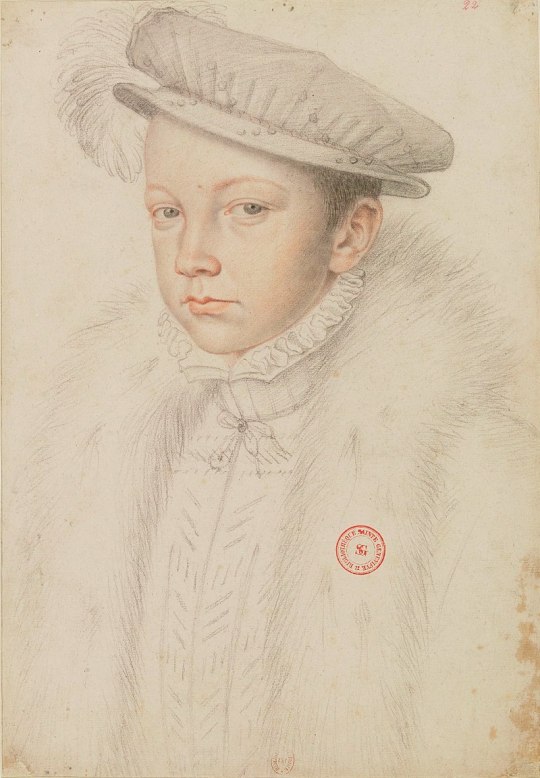

On December 5th 1560 King Francis II of France, the husband of Mary Queen of Scots, died.
Although not crowned it has to be remembered that Francis was also King consort of Scotland.
Francis was born on 19th January 1544, the eldest son of Henry II of France and Catherine de Medici, he was named for his grandfather, King Francis I. When Francis was four years old, the Scots and French signed the Treaty of Haddington in July 1548 arranging the betrothal of Mary Queen of Scots and the dauphin Francis in return for French aid to expel the invading English. Mary Queen of Scots sailed from Dumbarton for France in the August of 1548 when she was but five years old. The young Queen was accompanied by her four Marys, the daughters of Scottish noble families, Mary Beaton, Mary Seton, Mary Fleming and Mary Livingston.
Mary spent the rest of her childhood at the court of her father-in-law, Henri II Her father-in-law, Henry II of France wrote ‘from the very first day they met, my son and she got on as well together as if they had known each other for a long time’. Mary was a pretty child and brought up in the same nursery as her future husband and his siblings, became very attached to him. She corresponded regularly Mary of Guise , who remained in Scotland to rule as regent for her daughter. Much of her early life was spent at Château de Chambord. She was educated at the French court learning French, Latin, Greek, Spanish and Italian and enjoyed falconry, needlework, poetry, prose, horse riding and playing musical instruments.
Mary was the cosseted darling of the French court, the doting Henri II wrote 'The little Queen of Scots is the most perfect child I have ever seen.’ He corresponded frequently with Mary of Guise, expressing his delight in his young daughter-in-law. Mary’s maternal grandmother, Antoinette of Guise, in a letter to her daughter in Scotland, stated that she found Mary ’ very pretty, graceful and self assured.’
Francis and Mary were married with spectacular pageantry and magnificence in the cathedral of Notre Dame, Paris, by the Cardinal Archbishop of Rouen, in the presence of Henry II, Queen Catherine de’ Medici and a glittering throng of cardinals and nobles. The French courtier Pierre de Brantôme described Mary as ‘a hundred times more beautiful than a goddess of heaven … her person alone was worth a kingdom.’
Among the wedding guests was one, James Hepburn Earl of Bothwell. Francis was fourteen and Mary fifteen at the time, Francis then held the title King consort of Scotland until his death.
When Henri II was killed during a jousting contest, incidentally by Gabriel de Lorges, Comte de Montgomery, Captain of The Scots Guard, and a descendant of Alexander Montgomerie of Auchterhouse, Mary’s young husband Francois ascended the throne. Francis was reported to have found the crown of France so heavy that the nobles were obliged to hold it in place for him.
The young Francis became a tool of Mary’s maternal relations, the ambitious Guise family, who seized the chance for power and hoped to crush the Huguenots in France. The Huguenot leader, Louis de Bourbon, prince de Condé plotted the conspiracy of Amboise in March 1560, an abortive coup d'etat in which Huguenots surrounded the Château of Amboise and attempted to seize the King. The conspiracy was savagely put down, and its failure led to increase the power of the Guises. This alarmed the king ’s mother, Catherine de Medici, who reacted by attempting to secure the appointment of the moderate Michel de L'Hospital as chancellor.
During the autumn of 1560 François became increasingly ill, and died from the complications of an ear condition, in Orléans, Loiret. Since the marriage had borne no children, the French throne passed to his 10-year-old brother, Charles IX. Mary was said to be grief-stricken Multiple diseases have been suggested as the cause of Francis’ death, such as mastoiditis, meningitis, or otitis exacerbated into an abscess. Francis was buried in the Basilica of St Denis.
There was no place for the seventeen year old Mary, Queen of Scots in France, she prepared to return to her native Scotland with an uncertain future that would hold.
35 notes
·
View notes
Photo

La Bataille de Seneffe. Détail représentant le jeune duc d'Enghien (Henri III Jules de Bourbon-Condé) sauvant son père, le Grand Condé (Louis II de Bourbon, Prince de Condé). by Benigne Gagneraux
1 note
·
View note
Photo

Henri II de Bourbon-Condé et sa famille, vitrail de la Collégiale Saint-Martin de Montmorency
2 notes
·
View notes
Text

Le « Voyage de Siam » par Tachard, illustré, et relié pour le Grand CondéMagnifique « exemplaire de présent » à marges immenses de ce célèbre Voyage de Siam voulu par le roi Louis XIV relié pour le Grand Condé (1621-1686), premier prince du sang.
Édition originale de ce célèbre ouvrage décrivant la Thaïlande sous le règne du roi Louis XIV, dédicacé au roi.Brunet, V, 631.
Louis XIV diligenta lui-même cette mission au Siam, à la suite de la visite d'ambassadeurs siamois soucieux d'établir des liens commerciaux et politiques avec la France.
En 1680, la France obtint le monopole du commerce d’épices au Siam. Suite à la visite à Versailles du père Bénigne Vachet, prêtre des Missions Étrangères de Paris, et convaincu de ce que le roi du Siam Phra Naï (Narai) pouvait être converti au catholicisme, le roi Louis XIV décida en 1685 d'envoyer une ambassade au Siam, dirigée par le chevalier Alexandre de Chaumont. Avec l'aide du père La Chaise, confesseur du roi, les jésuites français purent adjoindre à l'expédition six jésuites mathématiciens qui devaient ensuite rejoindre la Chine, et recueillir sur ce pays toutes les observations utiles au commerce, à la politique, aux sciences et à la religion. Le supérieur de ces six jésuites mathématiciens était le père Tachard, originaire d'Angoulême. L'abbé de Choisy participait également à ce voyage en tant qu'historiographe. Ils arrivèrent en septembre 1685 à Lopburi, où le roi les reçut avec les plus grands honneurs. Le père Tachard, désigné pour aller chercher des missionnaires en Europe, rembarqua avec M. de Chaumont et une ambassade siamoise envoyée auprès de Louis xiv par Phra Naï sur les conseils de son principal ministre.
Né en 1651 à Marthon, près d'Angoulême, le père Tachards'avère être, outre un excellent mathématicien, un grand voyageur. Dès 1680, on le trouve aux Antilles avec d'Estrée. « Le père Tachard, Jésuite, a dit la Messe : il a été aux îles de l'Amérique, et a le pied marin.» (Journal de Choisy - 4 mars). Lorsqu'il s'embarque avec le Chevalier de Chaumont en 1685, il accomplit son premier voyage en Orient, voyage qui sera suivi de quatre autres. Parmi les six jésuites envoyés en Chine, le père Tachard est le seul à revenir en France avec le chevalier de Chaumont. A cela, une raison officielle : le roi Naraï souhaite installer un observatoire à Louvo, il a besoin de mathématiciens et d'astronomes et il charge le jésuite d'aller en recruter pour lui en France, mais aussi une raison officieuse : convaincre Louis XIV d'envoyer de nouvelles ambassades ainsi que des troupes au Siam. Le père Tachard est l'instrument idéal entre les mains du Grec du Phaulkon, le conseiller du roi du Siam. Ce dernier n'apprécie guère le chevalier de Chaumont et ne peut raisonnablement compter sur lui pour défendre ses projets auprès du roi de France. Crédule et ambitieux, le jésuite s'avère vite être le messager idéal. C'est lui qui fera miroiter auprès de Louis XIV les avantages d'une alliance avec le Siam.
Le chevalier de Forbin évoque ainsi cet épisode : « Il [Phaulkon] commença par s'ouvrir d'abord à M. de Chaumont, à qui il fit entendre que les Hollandais, dans le dessein d'agrandir leur commerce, avaient souhaité depuis longtemps un établissement à Siam ; que le roi n'en avait jamais voulu entendre parler, craignant l'humeur impérieuse de cette nation et appréhendant qu'ils ne se rendissent maîtres de ses états ; mais que si le roi de France, sur la bonne foi de qui il avait plus à compter voulait entrer en traité avec sa Majesté siamoise, il se faisait fort de lui faire remettre la forteresse de Bangkok, place importante dans le royaume, et qui en est comme la clef, à condition toutefois qu'on y enverrait des troupes, des ingénieurs, et tout l'argent qui serait nécessaire pour commencer l'établissement. Monsieur de Chaumont et M. l'abbé de Choisy, à qui cette affaire avait été communiquée, ne la jugeant pas faisable, ne voulurent pas s'en charger. Le père Tachard n'y fit pas tant de difficulté. Ébloui d'abord par les avantages qu'il crut que le roi retirerait de cette alliance, flatté enfin par les promesses de M. Constance qui s'engagea à faire un établissement considérable aux Jésuites: en un mot, ce père ne voyant rien dans tout ce projet que de très avantageux pour le roi, pour la religion et pour sa Compagnie, n'hésita pas à se charger de cette négociation ; il se flatta même d'en venir à bout et le promit à M. Constance. Dès lors, le père Tachard eut tout le secret de l'ambassade, et il fut déterminé qu'il retournerait en France avec les ambassadeurs siamois.» Toutefois, dans la relation de son voyage, le père Tachard laisse entendre qu'il n'avait nullement l'intention de retourner en France et qu'il n'aspirait qu'à se rendre en Chine, mais qu'il dût se résoudre à obéir.
De retour à Paris, le père Tachard joue à merveille le rôle que Phaulkon attendait de lui. Il devient l'interlocuteur privilégié du marquis de Seignelay, ministre de la marine, pour tout ce qui touche aux affaires de Siam. Il est le principal artisan de l'ambassade suivante, dont il fera partie. Il retourna au Siam en 1687 puis servit d’interprète aux mandarins siamois près de Louis XIV en 1688 et à la Cour de Rome en 1689. Cette première relation abonde en détails pittoresques et précis sur les mœurs et coutumes, la faune et la flore du Siam.« Les observations scientifiques relatées sont exactes ». Hoefer.L’ouvrage est orné en premier tirage de sept belles gravures en tête de la dédicace et des six livres par Sevin, décrivant la réception par Louis xiv des ambassadeurs siamois, la séance de l'Académie royale où fut décidée la mission, les parades navales, une ville du Siam, une place et des obélisques au Siam, l'observation par le Roi des astres au Siam...20 grandes estampes, dont 10 sur double page évoquent les contrées explorées notamment le Cap de Bonne Espérance et le port de Batavia, les indigènes Hottentots et Namaquas, les navires royaux, les mandarins, la faune et la flore (rhinocéros, éléphant, caméléon, thé, ginseng...).Toutes ces gravures sont signées d’après Sévin, De Cornelis Vermeulen, de l'école flamande, maître en 1682 et graveur depuis cette date à Paris dans l'atelier d’Edelinck.Précieux et merveilleux exemplaire, l’un des rarissimes à très grandes marges dits « de présent », mesurant 25 mm de plus que l’exemplaire de Louis-César de Cremaux, marquis d’Entragues vendu 35 000 € il y a cinq ans.Le présent exemplaire est relié en maroquin rouge de l’époque aux armes et symboles du Grand Condé (1621-1686).Louis II de Bourbon, prince de Condé, duc de Bourbon, d'Enghien, de Châteauroux, de Montmorency, de Bellegarde et de Fronsac, premier prince du sang, dit le Grand Condé, fils d'Henri II, gouverneur de Bourgogne, et de Charlotte-Marguerite de Montmorency, naquit à Paris le 8 septembre 1621 et porta les titres de duc d'Enghien, de prince de Condé et de Monsieur le Prince, à la mort de son père (1646). Le 11 février 1641 il épousa Claire-Clémence de Maille-Brézé, duchesse de Fronsac et de Caumont, marquise de Brézé, nièce de Richelieu, qui confia à son illustre neveu le commandement de l'armée française. Âgé seulement de 22 ans, il remporta sur les Espagnols, la célèbre victoire de Rocroy, le 19 mai 1643. Il fut nommé gouverneur de Champagne et de Brie le 16 mai 1644, puis de Berry le l janvier 1647, reçut la charge de grand maître de la maison du roi le même jour, le gouvernement de Bourgogne et de Bresse le 5 janvier et le titre de vice-roi de Catalogne le 4 mars ; après la paix de Munster (octobre 1648), il soutint la cour pendant la première Fronde, mais ses prétentions le firent arrêter le 18 janvier 1650 ; mis en liberté le 13 février 1651, après un an de détention au château de Vincennes, à Marcoussis et au Havre, et bien qu'il eût été nommé gouverneur de Guyenne le 16 mai 1651, Condé n'aspira plus qu'à se venger de la reine, et à la tête de l'Armée des Princes, il combattit l'armée royale commandée par Turenne; après sa défaite du faubourg Saint-Antoine, il dût se réfugier aux Pays-Bas et servit contre la France comme généralissime des armées d'Espagne du 25 novembre 1652 jusqu'à la paix des Pyrénées (1659) qui lui permit de rentrer en France, d’obtenir son pardon et d'être réintégré dans toutes les charges dont il avait été destitué en 1654. Créé chevalier des ordres du Roi, le 31 décembre 1661, le prince de Condé ne reçut un nouveau commandement qu'en 1668 ; peu après sa victoire de Seneffe, il se retira dans son château de Chantilly (1675) où il vécut entouré d'écrivains et d'artistes; il mourut à Fontainebleau le 11 décembre 1686.Le Grand Condé avait formé à Paris une bibliothèque composée d'environ 10000 volumes ; cette collection passa à son fils Henri-Jules, qui l'enrichit considérablement, mais à la mort de ce dernier (1709), elle fut complètement dispersée. Le volume porte sur la garde cette mention manuscrite du XIXe siècle « c’est peut-être le dernier volume qui ait été relié pour le Grand Condé. On sait en effet que le Prince mourut à Fontainebleau le 11 décembre 1686 à 7 heures ¼ du soir… ».
https://camillesourget.com/9493-livres-rares-edition-originale-livres-anciens-tachard-guy-voyage-de-siam-des-peres--magnifique-exemplaire-de-present-.html
0 notes